Motorola Droid RAZR Review - A Better Clad Bionic
by Brian Klug on December 16, 2011 2:01 AM EST- Posted in
- Smartphones
- Droid
- LTE
- 4G
- Motorola
- Android
- Mobile
- Droid RAZR
- motorola droid RAZR
Lapdock 100 and Accessories
For some reason, even though I’ve touched nearly all the Motorola Droids at some point or another, I’ve never managed to actually sit down and use one of the laptop docks. Sure, I poked at the Atrix lapdock for a little while back when that came out, but never really got the chance to experiment and try to fit it into my workflow.
This time we’ve got the Lapdock 100 which is compatible with virtually all of the newer laptop-dock enabled phones, including the RAZR, Atrix 2, Bionic, Electrify, and Photon 4G. That list is essentially all of the devices that ship with the webtop application installed with the exception of the Atrix. I didn’t realize it, but the older Atrix laptop dock is incompatible with these newer devices owing to the microHDMI and microUSB ports being position swapped.
In case Motorola’s lapdock concept is one that you haven’t been introduced to yet, the idea is to use the smartphone SoC in conjunction with some virtualization (called the Webtop Application) to drive a Linux desktop environment and a few applications on a larger canvas. The laptop dock doesn’t include much more than peripherals (keyboard and trackpad), a display, and battery - everything else really is running on the attached device. The smartphone display then becomes a window which you can interact with alongside desktop Firefox or a few other bundled applications. Running applications become tabs at the top of the smartphone window pane, and the android navigational buttons are at the bottom.
Firefox on the laptop dock includes Adobe Flash 10.1 as well, and although the version of Firefox running on the laptop dock isn’t bleeding edge at 6.0.2, it’s still a big step forwards from the Android 2.3 browser.
The Lapdock 100 includes a 10.1” 1366x768 display, internal battery for powering the device and the dock, a flexible connector for attaching to compatible phones, two USB ports, trackpad, and a netbook sized QWERTY keyboard with a few positional oddities but overall pretty responsive key domes. The only real issue I have with the keyboard is that the “,./” trio of keys at the right are compressed into a smaller than normal space to accommodate the arrow keys at far right. This is sort of standard netbook fare, although that’s to be expected considering the display’s 10.1” size.
The trackpad is probably the only major frustration I had with the Lapdock 100. I found it difficult to trigger the scroll gesture and instead resorted to using page up and page down for navigation, and it’s also easy to sometimes confuse right and left clicking since the buttons aren’t discrete but rather part of the trackpad area.
The big selling point for the Lapdock 100 (and the upcoming 500 Pro) over either the Bionic or Atrix docks is that they’re compatible with more than just one device, and future devices as well. On the Lapdock 100 instead of really getting a dock, there’s a rubberized flexible connector, and the phone then rests inside a rubberized pocket. I still had the Bionic kicking around and tried it with the Lapdock 100 in conjunction with the RAZR and sure enough things work perfectly. The only odd part about using the dock with the RAZR is that the cable isn’t quite long enough for it to lay horizontally in the rubberized area, instead the only way I could fit it in was vertically.
The Lapdock UI looks like what you’d get if you crossed motoblur with a linux desktop. There are some dock-like shortcuts at bottom, a status bar which mirrors Android’s status bar at the top, and the usual sort of window controls. I find myself wishing that Motorola would expose a developer mode and allow for a native shell inside the webtop application beyond just Firefox.
Unfortunately at this point the only webtop application types are really what ship with the device, what exist inside the Android mobile view, or HTML5 web apps which run inside Firefox, and there’s explicit mention of no shell access.
I mentioned the USB ports previously - these can be used in conjunction with any standard USB HID keyboard, mouse, or headset. In addition if a USB mass storage device is attached, it is automatically mounted and storage is visible to the webtop file manager application and to android as “usbdisk_1.3/” or similar depending on the device (as opposed to sdcard/ and sdcard-ext/ for those volumes).
There’s also the ability to print from the Lapdock using built-in CUPS over the network, which I tested with two Brother and Samsung network printers. The settings panes provide all the basic functionality you need to print, and Firefox likewise lets you shoot jobs over just fine.
The lapdock’s size makes it feel a lot like a netbook in the hands. The only place where it’s a bit clumsy is in the weight and balance department; nearly all the weight and thickness on the lapdock is at the back quarter presumably where the battery is. That makes it a bit weird to balance on your knees or hold with one hand compared to an ordinary notebook or netbook.
The lapdock is a good compliment to any of the compatible smartphones if nothing else because it’ll simultaneously charge the phone and give you a much bigger display to play around on. That said, there’s much more functionality that could be unlocked here were more open development (and not HTML5 webapps) enabled. Of course, the other thing is that the lapdock lets you essentially use a desktop browser without resorting to paying tethering fees or using a third party application. It’s cheaper at $249 (as of this writing) than the Chromebooks (which hover between $350 and $450) which subjectively offer the similar level of occasionally sluggish browsing performance.


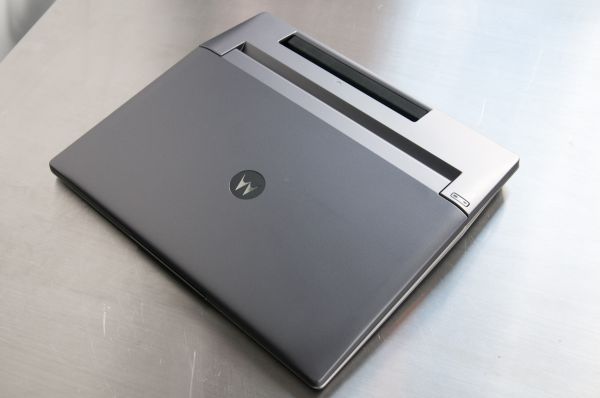


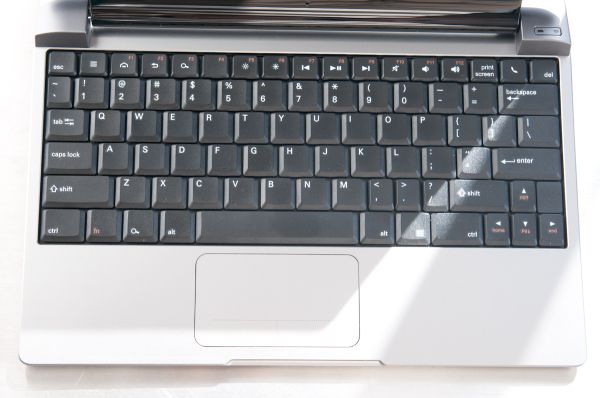
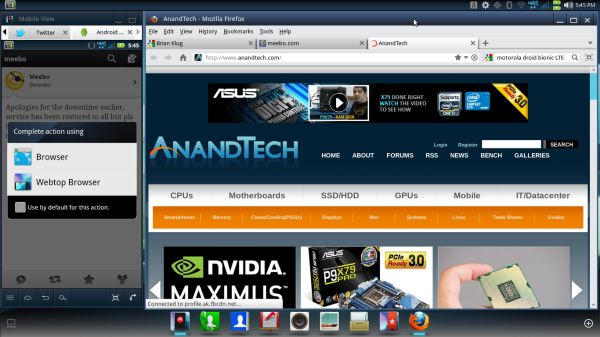
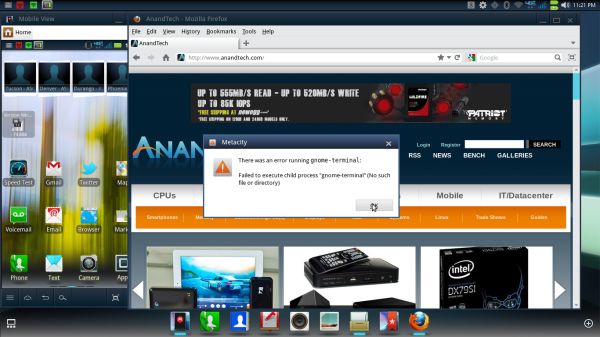
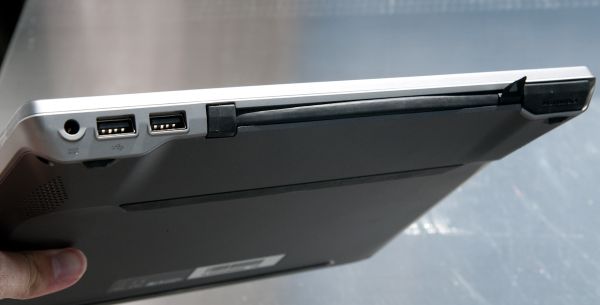















76 Comments
View All Comments
jjj - Friday, December 16, 2011 - link
It's not like you can buy any ICS devices yet ( the lack of SD on the Galaxy Nexus makes it a phone i wouldn't used if they payed me).The sad part is that it's not Krait or at least Tegra 3.As for when they'll get iCS and further updates,we'll see but it's doubtfull that any other manufacturer will be able to have faster updates that Googlerola.
zelachang - Friday, December 16, 2011 - link
How frequently do people really change out their SD cards? I have an OG Droid with 16 GB SD card from 2009 and I still haven't used up half the space. I wouldn't even consider multiple SD cards because I lose enough SD cards for my cameras, microSD cards would just fall in the couch or get eaten by my cats or something. When I first got my phone I thought I would end up swapping out cards a lot but for some reason I've never found a reason to.doobydoo - Tuesday, January 17, 2012 - link
Exactly, and even if you do run out of space you can simply plug it into a PC for 10 seconds, save all the documents, and continue.Or you could use Dropbox (on Android) or iCloud (on iOS) to completely negate the need for multiple SD cards unless you have unusual requirements.
Cali3350 - Friday, December 16, 2011 - link
I love your reviews, and I appreciate how in depth you guys go, but your reviews are getting increasingly more and more late and as a result less and less useful. This phone is over a month old at this point.I would love to see a Nexus review, but am assuming that cant occur until after Christmas, and that is not that helpful.
jeremyshaw - Saturday, December 17, 2011 - link
Quality. Anandtech beats all known in depth and thoroughness.doobydoo - Tuesday, January 17, 2012 - link
I actually agree with Cali3350, there is a point at which the quality becomes redundant if the phone was released so long ago. When a new phone is released, people don't want to wait over a month for a review, however high the quality - the most sales of any handset happen within that first month.I noticed the same thing happened with the iPhone 4S review, and made a comment to that effect at the time.
Quality is clearly excellent here, and this is definitely the best tech site - but by the time the reviews come out the article has already lost much of its value.
TrackSmart - Friday, December 16, 2011 - link
The Droid Charge review says the phone loses charge, even when plugged in, if using it as a hotspot. Same for navigating. This is a serious concern for me, especially when on-the-road.Are any of these LTE phones able to stay charged (when plugged in) while actively navigating or being used as a hotspot? I'm hoping you guys can weigh in.
I don't mind plugging in, while driving, but if I'm still going to have the phone die before my destination - that's bad news... Same regarding tethering over USB.
secretmanofagent - Friday, December 16, 2011 - link
I had the Bionic (swapped it out with a RAZR with all the data issues I was having), and I didn't have issues like I did with the original Droid. The original Droid would overheat and stop charging. I didn't have drain issues with the Bionic, haven't tried the RAZR yet.Brian Klug - Saturday, December 17, 2011 - link
The RAZR hasn't done the discharge-while-plugged-in dance the same as a bunch of other LTE phones. Navigation and hotspot use is fine on it, it'll charge while doing those activities if you use a charger that implements charging spec properly and has enough current.-Brian
TrackSmart - Saturday, December 17, 2011 - link
Thank you for the reply! This is comforting to hear. The Droid Charge article on Anandtech mentioned this problem and Engadget reported similarly on the Verizon version of the Galxy Nexus. That had me worried that this would be a more widespread problem.